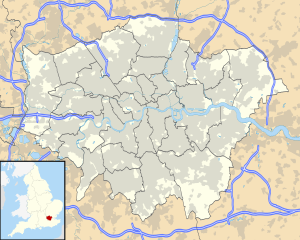Hammersmith Bridge
Coordinates: 51 ° 29 ′ 18 ″ N , 0 ° 13 ′ 50 ″ W.
| Hammersmith Bridge | ||
|---|---|---|
| Hammersmith Bridge | ||
| use | Road bridge | |
| Convicted | Main road |
|
| Crossing of | Thames | |
| place | London | |
| construction | Chain bridge | |
| overall length | 213.36 m | |
| width | 13.11 m | |
| start of building | 1st bridge - 1825 2nd bridge - 1884 |
|
| opening | 1st bridge - 1827 2nd bridge - June 11, 1887 |
|
| location | ||
|
|
||
The Hammersmith Bridge is a road bridge over the River Thames in London . It connects Hammersmith in the London Borough of Hammersmith and Fulham in the north with Barnes in the London Borough of Richmond upon Thames in the south. The wrought iron suspension bridge is 213.36 m (700 ft. ) Long and 13.11 m (43 ft.) Wide and is crossed by the A306 main road. The bridge that exists today is the second at this point.
history
In 1824 parliament passed a law that allowed the construction of a bridge. William Tierney Clark designed the very first suspension bridge over the Thames, and construction began the following year. After the opening in 1827, use was subject to a toll ; There were small toll booths at both ends of the bridge. During the 1870s, it was planned to replace it with a new building, as the existing bridge was no longer strong enough for the steadily increasing traffic.
The new construction began in 1884. In order not to impair traffic too much during the construction period, a temporary bridge was built in parallel. The new chain bridge, designed by Joseph Bazalgette , rests on the same foundations as the first. The official opening took place on June 11, 1887 by the Prince of Wales, later King Edward VII , and the construction costs were £ 82,117.
From February 1997 to July 1998 the bridge was closed to private motorized traffic in order to be able to carry out urgently needed repairs. The bridge has been the target of bomb attacks by the IRA and its splinter groups three times . A passerby prevented worse things from happening in 1939 when he discovered the briefcase with the bomb and threw it into the river. The attack in 1996 failed because the Semtex used did not ignite. The June 1, 2000 bomb, however, caused extensive property damage. After the repair work was completed, a weight limit of 7.5 tons was imposed.
Web links
- Hammersmith Bridge. In: Structurae
- Hammersmith Bridge website ( August 5, 2009 memento on the Internet Archive )
|
up the river Barnes Railway Bridge |
River crossings of the Thames |
downstream Putney Bridge |



